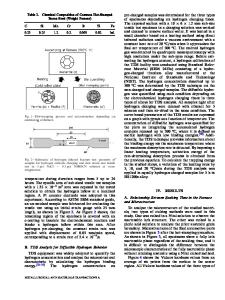Part I-the effects of pre-dissolved hydrogen on cleavage and grain boundary fracture initiation in metastable beta Ti-3A
- PDF / 2,932,331 Bytes
- 15 Pages / 612 x 792 pts (letter) Page_size
- 34 Downloads / 313 Views
I. INTRODUCTION to elevated temperature bulk hydrogen (H) charging, by either cathodic polarization in extremely acidic environments or gaseous H2 followed by static or monotonic loading at room temperature, embrittles smooth, notched and precracked b-titanium alloys, as determined by changes in tensile ductility, cleavage fracture stress, and fracture morphology. Table I lists various beta Ti alloys that show susceptibility to H-assisted embrittlement. Studies of a-b and metastable b-titanium alloys in aqueous solutions attribute environmental cracking susceptibility to a hydrogen environment-assisted cracking (HEAC) mechanism.[6–11] Hydrogen was implicated in the aqueous cracking of STA Beta-C when precracked tensile specimens were cathodically polarized in acidified chloride solutions containing H2S.[11] Precracking has been shown to produce the conditions necessary for crack tip H uptake in aqueous solutions.*
AMBIENT
*The TiO2 oxide films act as H permeation barriers to H uptake.[12] In aqueous environments, hydrogen uptake occurs under dynamic strain (which ruptures the oxide film) and is local to the crack tip.[13] Bulk charging can occur at elevated temperatures or in extremely acidic environments, both of which destabilize the barrier oxide film.
MICHELLE A. GAUDETT, formerly Research Assistant with the Department of Materials Science and Engineering, University of Virginia, is now a Materials Engineer, Naval Surface Warfare Center, West Bethesda, MD 20817. JOHN R. SCULLY, Associate Professor, is with the Department of Materials Science and Engineering, University of Virginia, Charlottesville, VA 22903. Manuscript submitted November 13, 1997. METALLURGICAL AND MATERIALS TRANSACTIONS A
The research described herein examines the H-assisted embrittlement of metastable beta Ti-3Al-8V-6Cr-4Mo-4Zr (Beta-C). Existing studies involving smooth,[11,14] notched[15] or precracked[16,17] specimens show immunity of aged BetaC to HEAC in ambient temperature 0.6 M NaCl (sy 5 1103 to 1490 MPa). However, it has been shown that fatigue precracked, dynamically loaded STA Beta-C is prone to intergranular HEAC in aqueous NaCl.[18] The threshold stress intensity for HEAC is reduced to one-third of the plane strain fracture toughness (KIC) and stage II subcritical crack growth rates are 30 to 100 mm/s.[18] In addition, cathodic precharging of notched STA Beta-C specimens to total H concentrations of greater than 1000 wt ppm. (5.1 at. pct) to reduce the uncertainty of aqueous occluding/straining influences on H uptake, reduces the fracture initiation stress by 50 pct from the uncharged condition and also introduces an intergranular (IG) fracture mode.[19] It is believed that lack of an occluded crack tip[11,14] and/or a lack of dynamic straining conditions[11,16,17] contributed to the observation of immunity.[13] These results show that it is important to understand the governing factors that control HEAC in STA Beta-C and other high-strength beta-Ti alloys in order to assess their susceptibility to HEAC. Hydride formation is
Data Loading...











